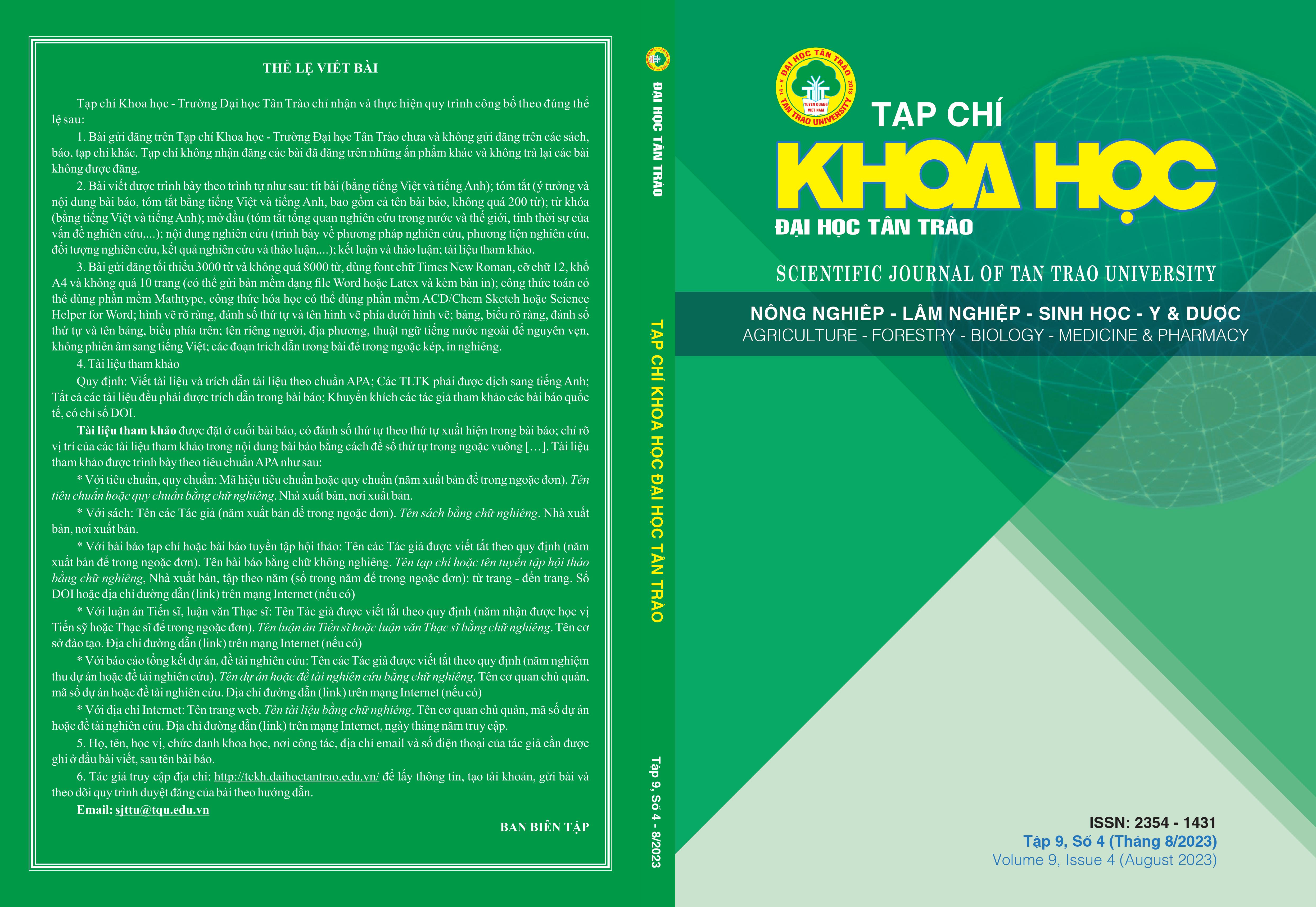ĐÁNH GIÁ HIỆN TRẠNG CHẤT LƯỢNG NGUỒN NƯỚC CẤP CHO NUÔI TRỒNG THUỶ SẢN TẠI HUYỆN BẢO THẮNG, TỈNH LÀO CAI
DOI:
https://doi.org/10.51453/2354-1431/2023/1002Từ khóa:
Ao nuôi, chất lượng nguồn nước, hộ gia đình, nuôi trồng thủy sản, Lào CaiTóm tắt
Huyện Bảo Thắng là nguồn cung cấp thủy sản lớn nhất cho tỉnh Lào Cai và một số tỉnh lận cận. Nước cấp cho nuôi trồng thủy sản trên địa bàn Huyện đang bị ảnh hưởng bởi rất nhiều nguồn ô nhiễm: sinh hoạt, công nghiệp, nông nghiệp (trồng trọt, chăn nuôi trên cạn) và chính hoạt động nuôi trồng thủy sản tại các ao nuôi. Vì vậy, việc tiến hành đánh giá hiện trạng chất lượng nước cấp cho nuôi trồng thủy sản là rất cần thiết, từ đó có các giải pháp nâng cao sản lượng, chất lượng thủy sản trên địa bàn Huyện. Trong nghiên cứu này, sử dụng phương pháp điều tra phỏng vấn người dân để thu thập thông tin về nguồn nước và phân tích mẫu các nguồn nước để đánh giá chất lượng môi trường nước cấp cho các ao nuôi trồng thủy sản. Kết quả nghiên cứu cho thấy, nguồn cấp nước nuôi trồng thủy sản trên địa bàn huyện Bảo Thắng bao gồm nước khe, nước suối, nước mưa và nước từ các hồ thuỷ lợi trong khu vực; 72,56% các hộ được hỏi cho biết nguồn dẫn nước trực tiếp từ nguồn vào ao nuôi trồng thuỷ sản của hộ gia đình; 100% các hộ gia đình không thực hiện xử lý nguồn nước cấp vào các ao nuôi cá; 54,29% các hộ được hỏi không sử dụng thiết bị xử lý trong ao nuôi và 75,71% các hộ được hỏi không sử dụng chế phẩm trong quá trình nuôi cá. Hiện trạng chất lượng các nguồn nước cấp nuôi trồng thuỷ sản trên địa bàn huyện Bảo Thắng cơ bản đảm bảo QCVN 08-MT:2015/BTNMT (Cột B1). Cục bộ có điểm ô nhiễm chất hữu cơ, cặn lơ lửng và có hàm lượng sắt cao.
Tải xuống
Tài liệu tham khảo
[1] Mr. P.T, C. Kroeze, S.R. Bush and A. P. J. Mol. (2010a), Water pollution from Pangasius (Pangasius) farming in the Mekong Delta, Vietnam: causes and control options, Fishery Sector Studies 42, 108 – 128.
[2] Mr. P.T, C. Kroeze, S.R. Bush and A. P. J. Mol. (2010b), Water pollution from intensive brackish water shrimp farming in Southeast Vietnam: Causes and control options, Agricultural Water Management 97: 872–882.
[3] Akinbile C. O., & Yusoff M. S. (2012), Assessing water hyacinth (Eichhornia crassopes) and lettuce (Pistia stratiotes) effectiveness in aquaculture treatment, International Journal of phytoremediation, 14(3), 201-211.
[4] Ministry of Agriculture and Rural Development, Project on environmental pollution control in aquaculture up to 2020.
[5] Boyd, C. E., & Gross, A. (1998), Use of probiotics for improving soil and water quality in aquaculture ponds, Advances in shrimp biotechnology, 101-105.
[6] Cong Van Nguyen (2017), Overview of Agricultural Pollution in Vietnam: Fisheries Sector, World Bank Regional Agricultural Pollution Study.
[7] De Silva, S. S., B. A. Ingram, N. T. Phuong, B. M. Tam, G. Gooley J., and G. M. Turchini (2010), Estimation of Nitrogen and Phosphorus in Wastewater of Pangasius Farming in the Mekong Delta, Vietnam, AMBIO Report, Doi: 10.1007/s13280-010-0072-x.
[8] Giang, N.T.H., Quyen, H.T., (2018), Wastewater treatment of commercial vannamei shrimp farming by a biological pond system combining fish, seaweed and shellfish in Vinh Thach commune, Vinh Linh district, province Quang Tri, Hue University Science Review: Engineering and Technology, vol. 127(2A-2018), pp.95-107.
[9] Dimitri X., Tho Bach Tent, Wang C., Han B. (2013), Low-cost wastewater treatment, Construction Publishing House, Hanoi.
[10] Li, G., Wu, Z., Cheng, S., Liang, W., He, F., Fu, G., & Zhong, F. (2007), Application of constructed wetlands on wastewater treatment for aquaculture ponds, Wuhan University Journal of Natural Sciences, 12(6), 1131-1135.
Tải xuống
Đã Xuất bản
Cách trích dẫn
Số
Chuyên mục
Giấy phép

Tác phẩm này được cấp phép theo Giấy phép Quốc tế Creative Commons Attribution-ShareAlike 4.0 .
Bài báo được xuất bản ở Tạp chí Khoa học Đại học Tân Trào được cấp phép theo giấy phép Ghi công - Chia sẻ tương tự 4.0 Quốc tế (CC BY-SA). Theo đó, các tác giả khác có thể sao chép, chuyển đổi hay phân phối lại các bài báo này với mục đích hợp pháp trên mọi phương tiện, với điều kiện họ trích dẫn tác giả, Tạp chí Khoa học Đại học Tân Trào và đường link đến bản quyền; nêu rõ các thay đổi đã thực hiện và các nghiên cứu đăng lại được tiến hành theo cùng một bản quyền.
Bản quyền bài báo thuộc về các tác giả, không hạn chế số lượng. Tạp chí Khoa học Tân Trào được cấp giấy phép không độc quyền để xuất bản bài báo với tư cách nhà xuất bản nguồn, kèm theo quyền thương mại để in các bài báo cung cấp cho các thư viện và cá nhân.
Mặc dù các điều khoản của giấy phép CC BY-SA không dành cho các tác giả (với tư cách là người giữ bản quyền của bài báo, họ không bị hạn chế về quyền hạn), khi gửi bài tới Tạp chí Khoa học Đại học Tân Trào, tác giả cần đáp ứng quyền của độc giả, và cần cấp quyền cho bên thứ 3 sử dụng bài báo của họ trong phạm vi của giấy phép.






